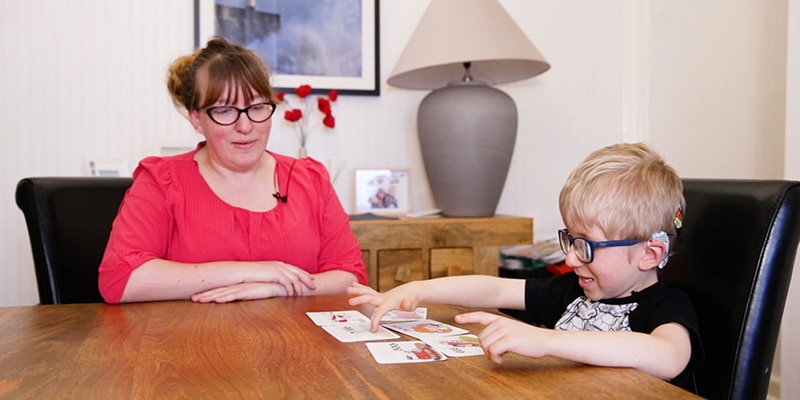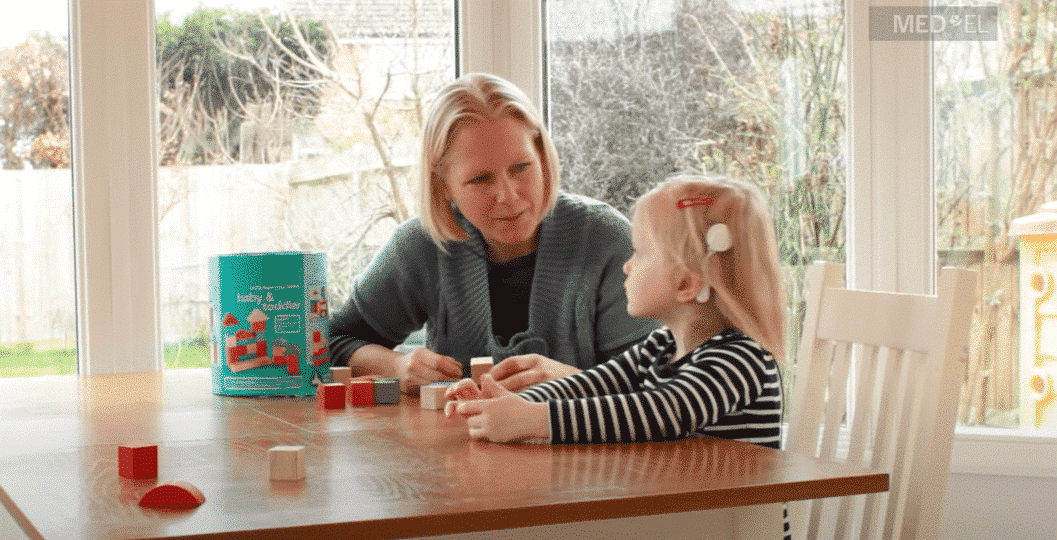
MED-EL
Published Nov 21, 2018
Rehab At Home: What Is The Ling Six Sound Test?
Today’s Rehab At Home post is about the Ling Six Sound Test. The Ling Test is a simple activity you can do each morning to check your child can hear all of the sounds of speech with their cochlear implant, or other hearing device. We recommend that you add the Ling Six Sound test to your routine every morning to make sure your child starts their day ready to listen, speak and learn using their hearing implants!

How Do I Do The Ling Six Sound Test?
As the name suggests, there are six sounds in the Ling Six Sound Test. These sounds represent the entire speech range from low to high frequency. If your child can hear these sounds they will be able to hear all of the sounds of speech.
- mm, as in me
- oo, as in boo
- ah, as in car
- ee, as in see
- sh, as in wish
- s, as in us
To carry out the test, simply say each of the sounds one at a time. Each sound should be said like it would be in a normal conversation, not too long or too short. The order doesn’t matter, as long as it’s random each time and you say the sounds with irregular pauses in between. This stops your child from guessing what sound might be said when.
If your child has two audio processors, do the test once for each device alone, to make sure each device is working well and then once with them together.
What you’re looking for is a signal that your child has heard the sound. A young child might blink, raise their eyebrows, look around to see where the sound came from, or stop what they’re doing. These responses tell us they have heard the sounds.
An older child or adult might point to a picture representing the sound, or repeat the sounds back as Penny and Matthew did in the video. As your child gets older and becomes more familiar with the test, expect them to imitate the sounds back to you. This tells you that not only did they hear the sounds, but were also able to identify them and discriminate them from the other sounds.
Once they’ve shown that they heard or identified the sound, give them something back. This could be a tickle for a baby, a turn at a game for a child, or telling a teen or adult that they’ve heard the sound.
Where Should I Do The Test?
The test should be done:
- in a quiet environment
- at a conversational volume
You’re testing if your child can functionally hear the sounds, so it’s important that they don’t get any other clues that a sound has been said. That means not being able to see your lips, feel your breath, or feel the vibration of your body while you say the sounds.
You can do this by having your child look somewhere else, or by putting something in front of your mouth (as long as it doesn’t keep the sound from being heard). Remember, if your child is sitting on your lap they may be able to feel the vibrations of your voice making the sound. You can avoid this by having them sit somewhere else, or have another person say the sounds as you hold them.
Ideally, your child should hear all of the Ling sounds from distance three meter distance in a quiet environment. By completing the test at three meters, you will gain information about whether your child is able to hear speech at a distance. This is important as we know that children also learn language and social skills by overhearing the conversations around them. Once your child is familiar with the Ling Six Sound Test and is able to detect or imitate the sounds (depending on their age) from one meter, increase your distance up to three meters.
The Ling Six Sound Test only gives you information about your child’s listening in situations similar to the one you did the test in. If you want to check your child’s listening in different situations, you’ll need to change the environment. You can do this by moving further away from your child or by adding some background noise, like a TV or air conditioner.
When Should I Do The Test?
You should do the Ling Six Sound Test each morning. If your child is already at school, you should do the test before they set off in the morning. That way, you can double check that their cochlear implants are working properly and that they are ready for learning.
It’s a good idea to write down each day’s test results in a diary, including the environment where you did it. This allows you to track your child’s hearing in different listening environments and see if any potential changes in hearing arise. Make sure to take the diary along to each meeting you have with your audiologist or hearing professional, because it can give them an idea of how well your child has been hearing the sounds of speech since your last appointment.
What If My Child Can’t Hear The Sounds?
If your child doesn’t respond to one or some of the sounds you’ve said, then that means they might not be hearing a specific sound in the way that it’s being spoken. There are different reasons why they might not be able to hear some of the sounds. These include an audio processor that’s not working properly, dead batteries, ear infections, or other changes in hearing.
When this happens you could try changing how you say the sounds by saying them closer, louder, or longer. If you make any changes to how you say the sounds write this down as notes in the diary, because this is important information for their audiologist or hearing professional.
If your child still can’t hear a sound even after you’ve changed how you’re saying it, you might need to troubleshoot their audio processor and accessories. Make sure the audio processor is turned on and has fresh batteries, that the coil is working and over the implant, and that the microphones aren’t blocked. If you’ve checked these and still have further questions, it’s best to contact your audiologist right away. Let them know about the Ling Six Sound Test and what responses you did or didn’t get.
And if your child did respond positively to all the sounds, this lets you know that they’re ready for a new day of hearing: building their listening and speaking skills!
References
References

MED-EL
Was this article helpful?
Thanks for your feedback.
Sign up for newsletter below for more.
Thanks for your feedback.
Please leave your message below.
Thanks for your message. We will reply as soon as possible.
Send us a message
Field is required
John Doe
Field is required
name@mail.com
Field is required
What do you think?
© MED-EL Medical Electronics. All rights reserved. The content on this website is for general informational purposes only and should not be taken as medical advice. Contact your doctor or hearing specialist to learn what type of hearing solution suits your specific needs. Not all products, features, or indications are approved in all countries.
Jeanne mukandayisenga
August 24, 2023
Very interesting topics and am very happy to get some information about Ling Six Sound Test and how important is in children's hearing assessment and speech development.
Jeanne mukandayisenga
August 24, 2023
Very happy and thank you for these topics. am very excited to hear Ling Six Sound Test and how important is in children's hearing assessment and speech development.

MED-EL

MED-EL




Conversation
2 Comments